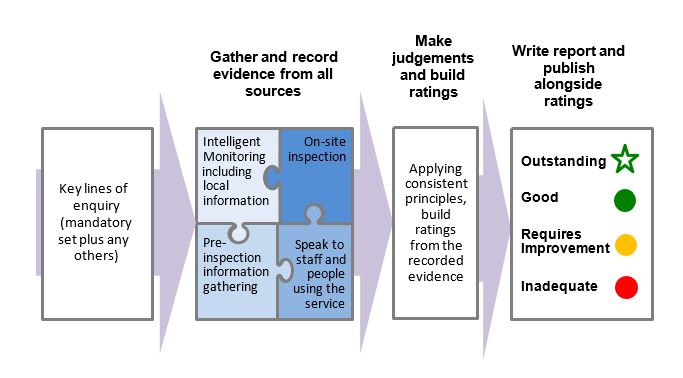
The one new concept, or to be more precise, the concept which has been returned to, is the awarding of ratings. The ratings will be:
- Outstanding
- Good
- Requires improvement
- Inadequate
How will CQC ratings be awarded?
The CQC state that: “Inspection teams will base their judgements on all the available evidence, using their professional judgement. They will particularly use the key lines of enquiry, the prompts and our guidance on the ratings levels” (Source – The CQC Provider’s Handbook, all versions). Therefore, the inspection will be the key driver, but as we have seen, Intelligent Monitoring (IM), a continuous process, will have an effect on the outcomes of inspection. Should IM indicate concerns, or concerns are raised during the inspection, further investigation over and above the initial inspection may take place.
First of all the CQC will use their ratings methodology and professional judgement to arrive at a rating for each of the five Key Questions – Safe?, Effective?, Caring?, Responsive?, Well-led?. For each of the five Key Questions the inspector will ask themselves:
- Does the evidence demonstrate that we can rate the service as good?
- If yes – does it exceed the standard of good and could it be outstanding?
- If no – does it reflect the characteristics of requires improvement or inadequate?
This flow chart illustrates the process:
Services will be rated ‘Inadequate’ usually where one or more regulations are breached. Some ‘Requires improvement’ services may also be in breach.
The process of arriving at the rating is further illustrated by this diagram from the CQC’s Provider Handbook.
The ratings characteristics are freely published by the CQC. Because they are too detailed to include in this article, the reader is advised to download them from:
The aggregation rules, leading from the five individual Key Questions rating to the overall rating are as follows:
Services are rated at two levels.
Level 1: Using rating methodology and professional judgement to produce separate ratings for each of the five Key Questions.
Level 2: Aggregate these separate ratings up to an overall location rating using ‘ratings principles’.
An illustration, from The CQC Provider’s Handbook, all versions

The principles can be modified by using professional judgement, having regard to all of the evidence. The CQC quote the following in the Provider’s Handbook as examples:
- Where the concerns identified have a very low impact on people who use services.
- Where we have confidence in the service to address concerns or where action has already been taken.
- Where a single concern has been identified in a small part of a very large and wide ranging service.
The CQC emphasise that the starting point of their deliberation is the description of a good service. They say that the characteristics are not a tick list; it is a guide to professional judgement. Not every characteristic has to be present, particularly at the extremes. For instance, they make the point that in an otherwise good service, one instance of an inadequate characteristic that affected service users could lead to an overall rating of ‘Inadequate’ whatever else the results were.
It is plain, therefore, that any provider, whether or not they are aiming for an ‘Outstanding’ rating, had best be absolutely certain that no standards are dropped across the board, lest they be banished to the outer reaches of ‘Inadequate’, and be totally out of the running for consideration of any outstanding characteristics. Conversely, the CQC say that: “Even those rated as outstanding are likely to have areas where they could improve.” (Source – The CQC Provider’s Handbook, all versions).
The CQC give passing mention to quality control and quality assurance in the statement “with consistency assured through the quality control and assurance process” (Source – The CQC Provider’s Handbook, all versions).
Quality Compliance Systems (QCS) would argue that this statement, and the preceding one “Even those rated as outstanding are likely to have areas where they could improve” fail to develop the concepts sufficiently to be of significant help to providers’ management strategy. This is no surprise, and not a criticism, because the CQC are not tasked with examining how good things happen, just whether or not they do. It is in filling in this gap that QCS comes into play.
The QCS approach to compliance management is that providers do not run their organisations to provide compliance. Compliance is not their customer. Their service users are their customer, and most providers have a passionate vision of what they want to achieve for their customers. That vision is usually expressed in such terms as “excellent”, “personal”, “wow factor” and similar entirely positive language. Therefore, providers develop leadership and management techniques to achieve their personal goals, which, based on the above language will be very close to the requirements of registration bodies. However, that leaves providers open to the risk of missing some vital element of registration (and other legal) compliance, even as they satisfy their own vision and their customers’ expectations. Also, in some cases, techniques of leadership and management are poorly understood by care managers who have risen through the vocational skills ranks without exposure to contemporary leadership concepts, and they feel that they do not have the skills, or the time, to square the circle of personal vision versus legal compliance.
It is precisely to fill this confidence gap that the QCS compliance system comes into play. The QCS system brings to its users a multi-dimensioned approach to care service management which is well suited to the new regulatory environment:
- A recognition that while excellent service does not flow from individual policies and procedures, however many of them there are, it does flow from the consistency which comprehensive, best practice, practical and well-applied policies and procedures can provide.
- QCS is the resource to seamlessly square the circle between the excellent care approach which providers want to provide and their legal compliance responsibilities. Our policies and procedures are based on best practice and when diligently applied through thorough staff training result in excellent safe and personalised services, while always meeting or exceeding legal standards.
- The QCS approach recognises that an excellent management system is not a collection of discrete policies – it is a comprehensive and consistent model which supports the user to achieve not just excellent results occasionally, but to achieve them consistently, and even continuously improve on them. The consistency is a result of the QCS quality assurance approach, which underpins every policy in the system.
How does QCS help you achieve the rating you want?
- QCS policies and procedures are consistent with ‘Good’ or ‘Outstanding’ characteristics. Over time, as the CQC’s definitions of Outstanding become clear, the policies will be updated to fully embrace that standard where achievement is practical.
- QCS provides you with the management model to create customer focused processes, which are also compliant, and happen consistently.
- QCS provides you with a new and very comprehensive set of stakeholder surveys, recognising that your achievement of many of the KLOEs can only be demonstrated by surveyed opinion, and providing you with a source of evidence for your accomplishment of those standards.
- QCS survey standards are entirely consistent with the policies and procedures; diligently execute the policies through effective training, and you will improve your survey outcomes, and be able to prove your service effectiveness to the CQC.
- QCS provides you with a simple but effective service quality development model which, combined with your work and the additional training of your staff, can take you from the rating you currently are to the rating you aspire to.
All-in-all, the QCS compliance management system provides you with all of the tools to be able to get on with your day-to-day business within a legally compliant and well managed framework, which supports high levels of rating awards and the structure to continuously improve.
Michael Dempsey – QCS Compliance Director



